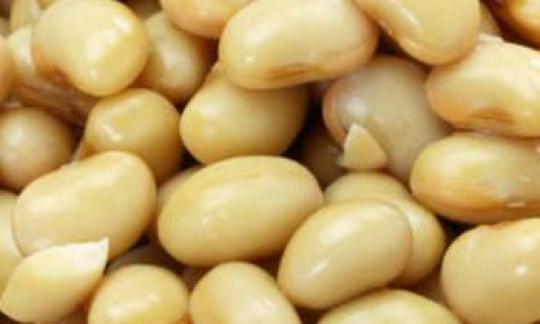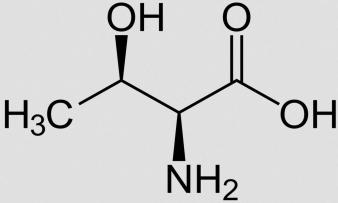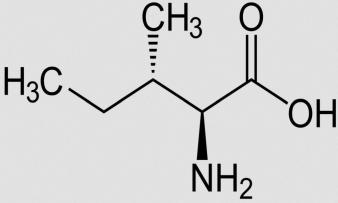Table of contents
The soybean ( Glycine max (L.) Merr.) is a legume that is very rich in protein. Cooked soybeans without salt can be used in various dishes.
Use in the kitchen
Soybeans must always be cooked, otherwise they are poisonous. Depending on the variety, they can be brown, green, red or cream-colored and their shape varies from small and round to curved and oblong. They have a slightly nutty taste. Soybeans harvested slightly unripe are called edamame. These are crunchier and sweeter in taste than the ripe seeds.
Cooked soybeans are very versatile. They are great warm in vegetarian or vegan stews, casseroles, curries, dals or soups and are ideal for filling meals. They also taste good with mixed vegetables, for example with carrots, red bell peppers, spinach and pak choi. They can be enjoyed cold as a topping in raw salads or made into hummus. You can also use them to make falafel or other patties.
Your own preparation
How can you process soybeans? Raw soybeans are processed in a similar way to chickpeas or borlotti beans. Soak the dried beans in water overnight or for at least 12 hours. Pour away the soaking water and rinse the soybeans again briefly with water. Then put them in a pot and fill it with water so that the beans are completely covered. The soybeans should boil for at least 10 minutes, then you can continue to cook them at a medium heat until they are soft.
Vegan recipe for soy vegetable curry with rice
Ingredients (for 4 people): 250 g cooked soybeans (or 125 g dried soybeans), 300 g brown rice, 1 onion, 2 carrots, 250 g spinach, 125 g mushrooms, 1 tbsp rapeseed oil, 2 tbsp curry powder, 2 tsp hot paprika powder, 2 tsp garam masala, 400 ml coconut milk (or alternatively soy cream),black pepper, salt, cinnamon.
Preparation: (Wash the soybeans and soak them in water for at least 12 hours. Drain the water and put the soybeans in a pot with water, bring to the boil and cook for 40 minutes at medium heat. Drain the soybeans again and let them drain.) Cook the rice in a pot with 2.5 times the amount of water.
Peel the onions and cut into thin rings. Wash the carrots and cut into small cubes. Wash the spinach and shake it dry. Clean the mushrooms and quarter them. Heat the rapeseed oil in a large pan and briefly sauté the onions with the curry and paprika powder and garam masala over a medium heat. Add the carrots, soybeans, mushrooms and spinach. Sauté for 5 minutes, then pour in the coconut milk or cream. Bring to the boil and cook for 5-10 minutes. Season the soy vegetable curry with cinnamon, salt and pepper and serve with the rice.
| Not only vegans or vegetarians should read this: Vegans often eat unhealthily. Avoidable nutritional errors. |
Purchasing - Storage
Cooked soybeans are available for sale all year round. They can occasionally be purchased at large supermarket chains such as Coop, Migros, Spar, Rewe, Edeka or Hofer. Other supermarkets such as Aldi, Denner, Volg, Lidl and Billa rarely stock soybeans. Cooked soybeans are often found in jars or cans, sometimes even in organic quality. Soybeans can also be bought in organic supermarkets such as Denn's Biomarkt or Alnatura or in health food stores as well as in Asian shops and online shops.
The availability of soybeans varies depending on the size of the store, catchment area, etc. If you are interested, click on our recorded food prices for the DA-CH countries (above under the ingredient image). There you will find current prices from various supermarkets and their price development.
Storage tips
Cooked and fresh beans will keep for a few days in the fridge. Pre-cooked soybeans can be frozen and then stored in the freezer for several months. Dried soybeans will keep for several years if stored correctly.
Ingredients - Nutritional values - Calories
Cooked soybeans (organic) contain 172 kcal per 100 g. The protein content of 18 g/100g covers 36.4% of the daily requirement. Dietary fiber is contained at 6 g/100g, which corresponds to 24% of the daily requirement. These values make soy a protein-rich food with a high fiber content. Cooked soybeans are low in carbohydrates (8.4 g/100g) and the fat content is also low at 9 g/100g. 1
All eight essential amino acids are contained in cooked soybeans. Cooked soy contains 0.24 g of tryptophan per 100 g, which covers 98% of the daily requirement. Threonine is also present in abundance at 0.72 g/100g (78% of the daily requirement). Isoleucine, lysine, phenylalanine, leucine and valine are present in larger quantities. Only methionine is present in smaller quantities. 1
Manganese is abundant, with 0.82 mg per 100 g of cooked soybeans. This corresponds to 41% of the daily requirement. Cashew nuts, roasted ordried bananas contain similar values. Baked falafel has 10 times as much manganese as the processed product (8.2 mg/100g). 1
Unsaturated fatty acids: The ratio between omega-6 and omega-3 fatty acids in cooked soybeans is 7:1 (see ingredient tables and link in the box above). 1 The Federal Office of Public Health ( FOPH) recommends that the value should not exceed 5:1 (LA:ALA) on average. However, most people consume significantly more omega-6 than omega-3 fatty acids. Erb muesli, for example, can correct this. If you enter the "sort by health values" option in the ingredients list, you can select healthy ingredients or those that compensate for a deficiency. The ratio is reversed for linseed, for example; it contains less potentially inflammatory LA (omega-6) and more anti-inflammatory omega-3 in the form of ALA. You can find out more about this in the link to olive oil.
The complete ingredients of cooked soybeans, the coverage of the daily requirement and comparison values with other ingredients can be found in our nutrient tables. In the article Nutrients explained you will get a detailed insight into the topic.
Effects on health
Soybeans contain all eight essential amino acids with a good biological value. The methionine content is lower than that of the other seven essential amino acids, but should not be underestimated. 1 Soybeans and soy products made from them are therefore a good vegan source of protein.
Soybeans contain isoflavones, plant-based substances that resemble the sex hormone estrogen, which is why they are classified as phytoestrogens. Their effect on the body has not yet been fully clarified. While certain studies show health benefits for the consumption of isoflavones, other studies show the opposite. 21,22 You can find more information on isoflavones under Soybeans (raw), Tofu or Tempeh.
Dangers - Intolerances - Side effects
Can you eat soybeans raw? Soybeans are poisonous when uncooked. Like other legumes, they contain poisonous lectins, which are sensitive to heat. A study shows that soybean lectins can be almost completely deactivated by cooking them covered with water for at least 10 minutes at 100 °C. In contrast, dry or moist heating (i.e. no water or only a little water) at 70 °C for several hours had little or no effect on the lectin content. 10 Germination reduces the lectin concentration in the soybeans. To be on the safe side, you should blanch the sprouts briefly and then throw away the cooking water. 11
Soybeans also contain antitrypsin, which inhibits the absorption of proteins. According to one study, soybeans should be soaked in a 0.25% bicarbonate solution for eight hours and then boiled for at least 20 minutes. This destroyed 80% of the antitrypsin activity of the soybeans. 12
Soya is one of the 14 main allergens and must therefore be declared on the ingredient lists of ready-made products. Eight of the proteins contained in soya are classified as allergens. 13 People who are allergic to flower pollen should also be careful, as cross-allergies with soya can often occur (especially in the case of a birch pollen allergy). 14
Ecological footprint - animal welfare
Global soy production has increased tenfold in the last 50 years, with the greatest expansion in South America. 15 In addition to the expansion of pastures for livestock, soy cultivation is the main cause of deforestation in Brazil, the largest producer of soy, but also in Paraguay and Bolivia. This is reflected in the ecological footprint of soy from these countries of origin. This change in land use (mainly through slash-and-burn) from rainforests to arable land releases the carbon stored in the trees and enters the atmosphere in the form of CO 2. 16
The direct environmental impacts in the affected regions are even more serious. The expansion of soy cultivation leads to the loss of remarkable and biologically unique habitats for plants and animals (loss of biodiversity). 15 The clearing of huge areas of forest and savannah (especially the Amazon and Cerrado regions) not only endangers local water resources, but also global water cycles. Droughts in neighboring areas are increasing and monoculture cultivation leads to soil degradation and water pollution in neighboring rivers and wetlands. 20
In the USA and Eastern Europe, on the other hand, the steady expansion of soy cultivation is taking place on existing farmland. 17 Under European climatic conditions, soy is an agriculturally important plant because it requires little fertilizer and contributes to humus enrichment of the soil by binding nitrogen from the environment. 18 The water consumption of soy plants depends on the soil, climate and cultivation method. Organic production reduces soil evaporation and thus the gray water footprint. 19
In tropical climates, soy is more susceptible to certain diseases and pests, 23 which is why cultivation in these areas usually involves intensive use of pesticides. 5,7 Since 1997, a genetically modified (transgenic) soybean has been approved in certain countries. This is tolerant to herbicides containing the active ingredient glyphosate (such as Roundup). Herbicide tolerance in genetically modified plants (e.g. GM soybeans) enables the large-scale use of pesticides (weed killers, herbicides). This application specifically kills all emerging weeds and the genetically modified, tolerant plant remains standing. Farmers are increasingly struggling with weed resistance and are therefore forced to combine the herbicide active ingredients. 7 Total herbicides help the plant to develop quickly without competition, but the impact on soil fertility and biodiversity is massive. 5
In 2019, 76% of the beans produced worldwide were genetically modified soy. 8 GMO-free soy is grown mainly in Europe, but also in Brazil and Russia. 9
Economically, the export of soybeans is a significant source of income for countries such as Brazil and Argentina, but only a small part of the population benefits from it. On the contrary, growing soy on land that was previously used for subsistence can even endanger the food supply and livelihood of the local population. 5
It should also be remembered that 76% of the world's soy harvest is used for animal feed in milk and meat production (2017-2019). Only 20% of soybeans and the products made from them (tofu, miso, etc.) are consumed directly by humans. A small part (4%) of the soy is processed into biodiesel and lubricants. 6
Worldwide occurrence - cultivation
The soybean originally comes from China. 2 Thanks to its wide range of processing and application options, soybeans are one of the most important crops in the world. According to the FAO, the most important growing countries in 2020 are Brazil, the United States, Argentina and the People's Republic of China. Brazil, as the largest producer, grew around 34.5% of the world harvest in 2020 (121,797,712 t). 4
Found in the wild
The cultivated soybean ( Glycine max (L.) Merr.) is descended from the wild soybean ( Glycine soja). This is found as a weed on river banks and in wetlands throughout China. It also grows in Korea, Japan, parts of Afghanistan and Russia. 3 It was probably cultivated in China around 5000–6000 years ago. The wild form has smaller seeds than the cultivated form. There are also semi-wild forms that have arisen through cross-breeding of cultivated and wild soybeans. 2
Cultivation - Harvest
Soybeans can be grown in the garden or in a large pot. You can find out more about this under the link to the ingredient Soybean, mature seeds.
Further information
The soybean ( Glycine max (L.) Merr.) is a plant species from the subfamily Faboideae, which belongs to the family Leguminosae or Fabaceae.
Alternative names
Soybeans are often also called edamame. Strictly speaking, this name only refers to beans that are harvested when they are slightly unripe. However, the name is also sometimes used for ripe soybeans. In English, they are called soybeans, soy beans or soya beans, and the cooked version is called boiled soybeans.
Bibliography - 23 Sources
| 1. | USDA United States Department of Agriculture. |
| 2. | Wang KJ, Li XH, Liu Y. Fine-scale phylogenetic structure and major events in the history of the current wild soybean (Glycine soja) and taxonomic assignment of semi-wild type (Glycine gracilis Skvortz.) within the Chinese subgenus Soja. J Hered. 2012 Jan-Feb;103(1): 13-27. |
| 3. | Wu ZY, Raven PH, Hong DY (eds). Flora of China. Vol. 10 (Fabaceae). Science Press Beijing, and Missouri Botanical Garden Press: St. Louis; 2010: 251. |
| 4. | FAOSTAT Food and Agriculture Organization of the United Nations. Soya Beans. 2020. |
| 5. | Bundesinformationszentrum Landwirtschaft. Soja - Nahrungsmittel für Tier und Mensch. |
| 6. | Our Wold in Data. Soy. 2021. |
| 7. | Transgen.de Sojabohne. 2022. |
| 8. | Transgen.de Gentechnisch veränderte Sojabohnen: Anbauflächen weltweit. 2021. |
| 9. | Transgen.de Ohne Gentechnik! Und wo kommt das Soja-Futter her? |
| 10. | Pusztai A, Grant G. Assessment of lectin inactivation by heat and digestion. Methods Mol Med. 1998;9: 505-14. |
| 11. | Kompetenzzentrum für Ernährung (KErn). Bayerische Landesanstalt für Landwirtschaft (LfL). Hülsenfrüchte (PDF). 2018. |
| 12. | Morales de León JC, Bourges Rodríguez H, Zardain MI. Cooking procedures for direct consumption of whole soybeans. Arch Latinoam Nutr. Juni 1985;35(2): 326–36. |
| 13. | Medizinische Universität Wien. Die 14 wichtigsten Allergene. |
| 14. | Bundesinstitut für Risikobewertung. Birkenpollenallergiker können auf Sojaprodukte besonders empfindlich reagieren. 2007. |
| 15. | WWF International. Der Sojaboom - Auswirkungen und Lösungswege. Report 2014. |
| 16. | Blonk Consultants. Environmental footprint of soy - Life Cycle Assessment. 2020. |
| 17. | Grenz J, Angnes G. Wirkungsanalyse: Nachhaltigkeit der Schweizer Soja-Importe. 2020. |
| 18. | Soja Netzwerk Schweiz. Faktenblätter Wunderpflanze Soja. 2020. |
| 19. | Ercin AE, Aldaya MM, Hoekstra AY. The Water footprint of soy milk and soy burger and equivalent animal products. Value of Water Research Report Series No 49. 2011. |
| 20. | WWF Deutschland. Soja: Wunderbohne mit riskanten Nebenwirkungen. 2020. |
| 21. | Boutas I, Kontogeorgi A, Dimitrakakis C, Kalantaridou SN. Soy isoflavones and breast cancer risk: a meta-analysis. In Vivo. 2022;36(2):556–62. |
| 22. | Douglas CC, Johnson SA, Arjmandi BH. Soy and its isoflavones: the truth behind the science in breast cancer. Anticancer Agents Med Chem. Oktober 2013;13(8):1178–87. |
| 23. | Rupe J, Luttrell RG. Effect of pests and diseases on soybean quality. In: Johnson LA et al. (eds.). Soybeans. Chemistry, Production, Processing, and Utilization. 2008:93–116. |








Comments